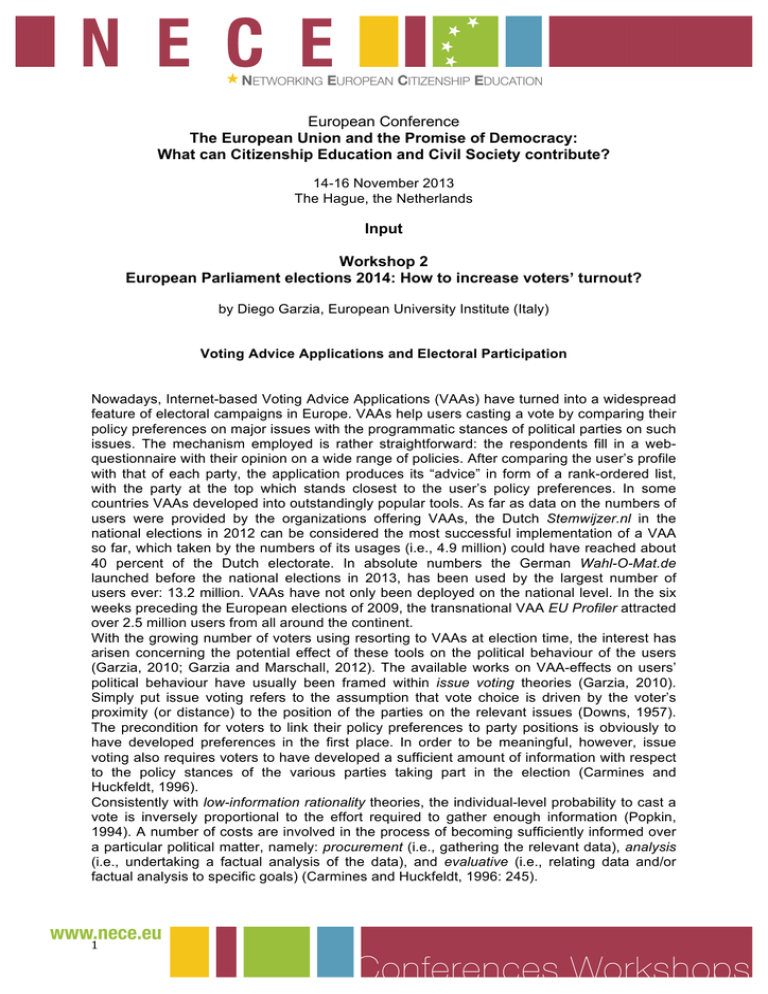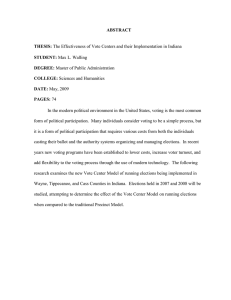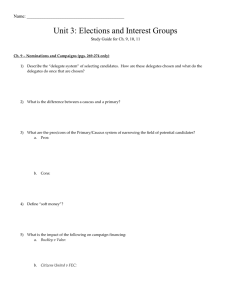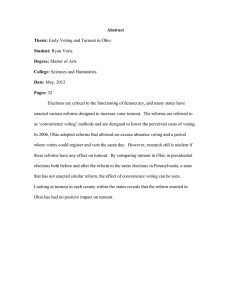Document 13156753
advertisement

European Conference The European Union and the Promise of Democracy: What can Citizenship Education and Civil Society contribute? 14-16 November 2013 The Hague, the Netherlands Input Workshop 2 European Parliament elections 2014: How to increase voters’ turnout? by Diego Garzia, European University Institute (Italy) Voting Advice Applications and Electoral Participation Nowadays, Internet-based Voting Advice Applications (VAAs) have turned into a widespread feature of electoral campaigns in Europe. VAAs help users casting a vote by comparing their policy preferences on major issues with the programmatic stances of political parties on such issues. The mechanism employed is rather straightforward: the respondents fill in a webquestionnaire with their opinion on a wide range of policies. After comparing the user’s profile with that of each party, the application produces its “advice” in form of a rank-ordered list, with the party at the top which stands closest to the user’s policy preferences. In some countries VAAs developed into outstandingly popular tools. As far as data on the numbers of users were provided by the organizations offering VAAs, the Dutch Stemwijzer.nl in the national elections in 2012 can be considered the most successful implementation of a VAA so far, which taken by the numbers of its usages (i.e., 4.9 million) could have reached about 40 percent of the Dutch electorate. In absolute numbers the German Wahl-O-Mat.de launched before the national elections in 2013, has been used by the largest number of users ever: 13.2 million. VAAs have not only been deployed on the national level. In the six weeks preceding the European elections of 2009, the transnational VAA EU Profiler attracted over 2.5 million users from all around the continent. With the growing number of voters using resorting to VAAs at election time, the interest has arisen concerning the potential effect of these tools on the political behaviour of the users (Garzia, 2010; Garzia and Marschall, 2012). The available works on VAA-effects on users’ political behaviour have usually been framed within issue voting theories (Garzia, 2010). Simply put issue voting refers to the assumption that vote choice is driven by the voter’s proximity (or distance) to the position of the parties on the relevant issues (Downs, 1957). The precondition for voters to link their policy preferences to party positions is obviously to have developed preferences in the first place. In order to be meaningful, however, issue voting also requires voters to have developed a sufficient amount of information with respect to the policy stances of the various parties taking part in the election (Carmines and Huckfeldt, 1996). Consistently with low-information rationality theories, the individual-level probability to cast a vote is inversely proportional to the effort required to gather enough information (Popkin, 1994). A number of costs are involved in the process of becoming sufficiently informed over a particular political matter, namely: procurement (i.e., gathering the relevant data), analysis (i.e., undertaking a factual analysis of the data), and evaluative (i.e., relating data and/or factual analysis to specific goals) (Carmines and Huckfeldt, 1996: 245). 1 On the basis of these strands of literature, contemporary reasoning voters are expected to cut the cost of casting a vote by relying on whatever ‘free’ or inexpensive information can be picked up. In this respect, VAAs represent a potentially relevant source of political information for their users. By comparing the voter’s position on the various issues with that of the parties, VAAs can significantly lower the costs related to the procurement, analysis and evaluation of information. Researches on the impact of political knowledge on turnout provide evidence that higher levels of political information correspond with a higher likelihood to turnout in elections (Delli Carpini and Keeter, 1996). In this sense, the usage of VAAs can be thought to reduce the cost of getting informed about politics and political parties, thereby increasing the chances of voting vis-à-vis abstention. The providers of VAAs bear great confidence in the mobilising capacity of these tools (Ruusuvirta and Rosema, 2009). Indeed, some VAAs are actually developed as an explicit attempt to mobilise voters and increase turnout (Marschall, 2005). The few available analyses of VAA-effects on turnout would seem to support this expectation. Studies of the impact of Wahl--‐O--‐Mat usage in German federal elections consistently find one Wahl‐O-‐Mat user out of ten declaring to feel more motivated to turnout because of having used that VAA (Marschall, 2005; Marschall and Schmidt, 2010). Further evidence in this direction comes from the Swiss case. An analysis of Smartvote 2007 data found about forty per cent of respondents declaring that using the VAA had a “decisive or at least slight influence on their decision to go to the polls” (Ladner and Pianzola, 2010). According to Fivaz and Nadig (2010), the overall turnout in that election could have been about five per cent lower had the smart vote platform not made available to Swiss voters. Similar conclusions are reported in Ruusuvirta and Rosema’s (2009) analysis of the Dutch election of 2006. According to their study, the massive usage of VAAs among the voting population increased turnout at that election by three per cent (Ruusuvirta and Rosema, 2009: 18). VAAs have also been found to exert significant effect in supranational elections. An analysis by Dinas, Trechsel and Vassil (2012) shows that even after controlling for a wide set of socio-structural, attitudinal and behavioural variables, the individual-level probability to cast a vote in the EP election of 2009 was 14 percentage points higher for EU Profiler users as compared to nonusers. 2 References list Carmines, E. G. and Huckfeldt, R. (1996) ‘Political Behavior: An Overview’, in Goodin, R. E. and Klingemann, H. D. (Eds.), A New Handbook of Political Science, Oxford University Press, New York, pp. 223-254. Delli Carpini, M. X. and Keeter, S. (1996) What Americans Know about Politics and Why It Matters, Yale University Press, New Haven and London. Dinas, E., Trechsel, A. H. and Vassil, K. (2011) ‘A Look into the Mirror. Preferences, Representation and Electoral Participation’. Paper presented at the Conference Internet, Voting and Democracy, 12-13 May 2011. Laguna Beach, The United States of America. Downs, A. (1957) ‘An Economic Theory of Political Action in a Democracy’, The Journal of Political Economy, Vol. 65 No. 2, pp. 135-150. Fivaz, J. and Nadig, G. (2010) ‘Impact of Voting Advice Applications (VAAs) on Voter Turnout and Their Potential Use for Civic Education’, Policy & Internet, Vol. 2 No. 4, pp. 167200. Garzia, D. and Marshall, S. (2012) ‘Voting Advice Applications under review: the state of research’, International Journal of Electronic Governance, Vol. 5 No. 3, pp. 203-222. Garzia, D. (2010) ‘The Effects of VAAs on Users’ Voting Behaviour: An Overview’, in Cedroni, L. and Garzia, D. (Eds.), Voting Advice Applications in Europe. The State of the Art, ScriptaWeb, Napoli, pp. 13-33. Ladner, A. and Pianzola, J. (2010) ‘Do Voting Advice Applications Have an Effect on Electoral Participation and Voter Turnout? Evicence from the 2007 Swiss Federal Elections‘, in Tambouris, E., Macintosh, A. and Glassey, O. (Eds.), Electronic Participation. Second IFIP WG 8.5 International Conference, ePart 2010, Lausanne, Switzerland, August 29– September 2, 2010. Proceedings, Springer, Berlin, pp. 211-224. Marschall, S. and Schmidt, C. K. (2010) ‘The Impact of Voting Indicators: The Case of the German Wahl-O-Mat’, in Cedroni, L. and Garzia, D. (Eds.), Voting Advice Applications in Europe. The State of the Art, ScriptaWeb, Napoli, pp. 65-104. Marschall, S. (2005) ‘Idee und Wirkung des Wahl-O-Mat’, Aus Politik und Zeitgeschichte, Vol. 55, No. 51-52, pp. 41-46. Popkin, S. (1994). The Reasoning Voter. Communication and Persuasion in Presidential Campaign. Chicago: University of Chicago Press. Ruusuvirta, O. and Rosema, M. (2009) ‘Do online vote selectors influence electoral participation and the direction of vote?’. Paper presented at The European Consortium for Political Research (ECPR) General Conference. 10-12 September 2009. Potsdam, Germany. 3







